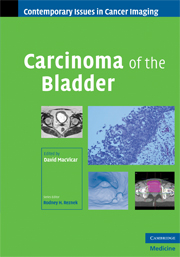Book contents
- Frontmatter
- Contents
- Contributors
- Series foreword
- Preface to Carcinoma of the Bladder
- 1 The pathology of bladder cancer
- 2 Clinical features of bladder cancer
- 3 Imaging in the diagnosis of bladder cancer
- 4 Radiological staging of primary bladder cancer
- 5 Imaging of metastatic bladder cancer
- 6 Surgery for bladder cancer
- 7 External beam radiotherapy for the treatment of muscle invasive bladder cancer
- 8 The chemotherapeutic management of bladder cancer
- 9 Clinical follow-up of bladder cancer
- 10 Imaging of treated bladder cancer
- Index
- Plate section
Preface to Carcinoma of the Bladder
Published online by Cambridge University Press: 25 August 2009
- Frontmatter
- Contents
- Contributors
- Series foreword
- Preface to Carcinoma of the Bladder
- 1 The pathology of bladder cancer
- 2 Clinical features of bladder cancer
- 3 Imaging in the diagnosis of bladder cancer
- 4 Radiological staging of primary bladder cancer
- 5 Imaging of metastatic bladder cancer
- 6 Surgery for bladder cancer
- 7 External beam radiotherapy for the treatment of muscle invasive bladder cancer
- 8 The chemotherapeutic management of bladder cancer
- 9 Clinical follow-up of bladder cancer
- 10 Imaging of treated bladder cancer
- Index
- Plate section
Summary
Cancer of the urinary bladder encompasses a range of cell types, the most common in Western societies being transitional cell carcinoma (TCC). These neoplasms are characterized by a spectrum from indolent, polypoid tumors to sessile, more biologically aggressive lesions. Initial management relies heavily on cytoscopic procedures, but as disease becomes more advanced, imaging becomes central to decision making. This volume draws together contributions from various specialities, including pathology, surgery, and clinical and medical oncology. The aim is to inform the radiologist of the range of surgical procedures which has been developed, and the possibilities for management with radiotherapy. Cytotoxic chemotherapy can be used in neoadjuvant, adjuvant and palliative settings. The role of imaging in diagnosis of disease of the urothelium, the techniques for staging bladder cancer and detection of metastatic disease are each discussed in separate chapters. Imaging following treatment, including effects on normal tissues, is also covered, and the multidisciplinary nature of management of bladder neoplasms is emphasized. In line with the ethos of the Contemporary Issues in Cancer Imaging series, it is hoped that this volume will give radiologists a broader view of the technical aspects of treatment, and colleagues in other specialities will be able to further their understanding of the contribution imaging can make in our endeavors to cure the disease and control symptoms in patients with bladder cancer.
- Type
- Chapter
- Information
- Carcinoma of the Bladder , pp. xi - xiiPublisher: Cambridge University PressPrint publication year: 2008

